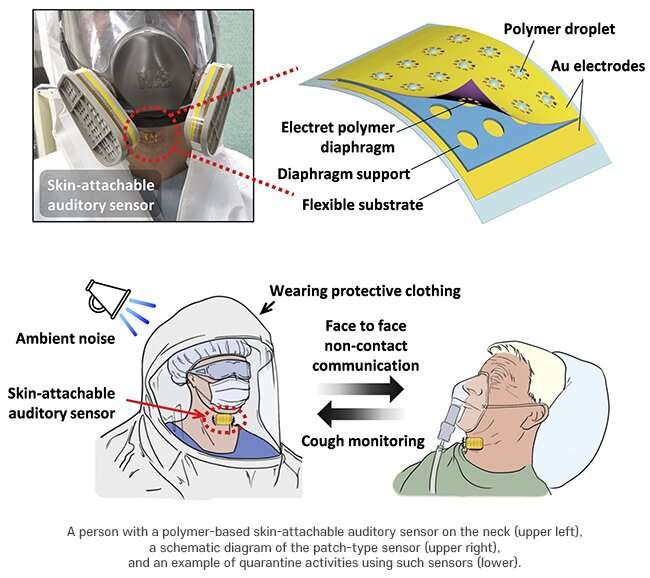Skin-attachable auditory sensor that functions even in noisy environments

Face masks, a new normal since the onset of the COVID-19 pandemic, muffle sound, making it difficult to understand speech. People often have no choice but to speak louder and strain their throat muscles. This communication stress may hinder rapid response in a hospital setting, fire emergency, or other urgent situations. Fortunately, a research team has recently developed a new intelligent microphone that will enable smoother communication in such events.
A research team led by Professor Kilwon Cho, Dr. Siyoung Lee and Hajung Roh (Department of Chemical Engineering) at POSTECH has developed a skin-attachable microphone sensor that clearly detects voices even in harsh noisy environments. Their work was highlighted on the back cover in the recent issue of Advanced Materials.
Microphones built into telephones and walkie-talkies are widely used in daily life and in industries. Conventional devices, however, fail to recognize human voices clearly in very windy or loud environments, or when the speaker is wearing a mask.
To overcome this shortcoming, the research team applied polymer electrets to microelectromechanical systems (MEMS) to develop an auditory sensor. The electret-powered and hole-patterned polymer diaphragm is incorporated into a skin-attachable auditory sensor, which reduces the necessity of a battery to work. The sophisticated diaphragm structure based on MEMS technology gives the auditory sensor high wearability and portability.
The diaphragm enables the sensor to detect the neck-skin vibration generated when a person speaks. Those using this sensor can clearly hear sounds even in a concert hall or other noisy places, or when their faces are completely covered with a gas mask.
This new technology can be used for disaster-response communication between medical professionals wearing protective equipment against respiratory diseases, including COVID-19, and firefighters wearing gas masks and other forms of turnout gear.
Furthermore, this technology will be applicable as a diagnostic device that identifies respiratory diseases by measuring the number or severity of coughs in real time or as a healthcare monitoring device that analyzes voice usage patterns to figure out whether the vocal cords are healthy.
More information: Siyoung Lee et al, An Electret‐Powered Skin‐Attachable Auditory Sensor that Functions in Harsh Acoustic Environments, Advanced Materials (2022). DOI: 10.1002/adma.202205537



















